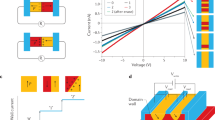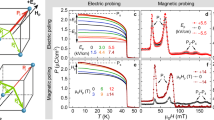Abstract
Ferroelectric domain walls hold great promise as functional two-dimensional materials because of their unusual electronic properties. Particularly intriguing are the so-called charged walls where a polarity mismatch causes local, diverging electrostatic potentials requiring charge compensation and hence a change in the electronic structure. These walls can exhibit significantly enhanced conductivity and serve as a circuit path. The development of all-domain-wall devices, however, also requires walls with controllable output to emulate electronic nano-components such as diodes and transistors. Here we demonstrate electric-field control of the electronic transport at ferroelectric domain walls. We reversibly switch from resistive to conductive behaviour at charged walls in semiconducting ErMnO3. We relate the transition to the formation—and eventual activation—of an inversion layer that acts as the channel for the charge transport. The findings provide new insight into the domain-wall physics in ferroelectrics and foreshadow the possibility to design elementary digital devices for all-domain-wall circuitry.
This is a preview of subscription content, access via your institution
Access options
Access Nature and 54 other Nature Portfolio journals
Get Nature+, our best-value online-access subscription
$29.99 / 30 days
cancel any time
Subscribe to this journal
Receive 12 print issues and online access
$259.00 per year
only $21.58 per issue
Buy this article
- Purchase on Springer Link
- Instant access to full article PDF
Prices may be subject to local taxes which are calculated during checkout




Similar content being viewed by others
References
Salje, E. K. H. Multiferroic domain boundaries as active memory devices: trajectories towards domain boundary engineering. Chem. Phys. Chem. 11, 940–950 (2010).
Catalan, G., Seidel, S., Ramesh, R. & Scott, J. F. Domain wall nanoelectronics. Rev. Mod. Phys. 84, 119–156 (2012).
Meier, D. Functional multiferroic domain walls in multiferroics. J. Phys. Condens. Matter 27, 463003 (2015).
Seidel, J. et al. Conduction at domain walls in oxide multiferroics. Nat. Mater. 8, 229–234 (2009).
Maksymovych, P. et al. Tunable metallic conductance in ferroelectric nanodomains. Nano Lett. 12, 209–213 (2012).
Schröder, M. et al. Conducting domain walls in lithium niobate single crystals. Adv. Funct. Mater. 22, 3936–3944 (2012).
Sluka, T. et al. Free-electron gas at charged domain walls in insulating BaTiO3 . Nat. Commun. 4, 1808 (2013).
Meier, D. et al. Anisotropic conductance at improper ferroelectric domain walls. Nat. Mater. 11, 284–288 (2012).
Wu, W., Horibe, Y., Lee, N., Cheong, S.-W. & Guest, J. R. Conduction of topologically protected charged ferroelectric domain walls. Phys. Rev. Lett. 108, 077203 (2012).
Oh, Y. S., Luo, X., Huang, F.-T., Wang, Y. & Cheong, S.-W. Experimental demonstration of hybrid improper ferroelectricity and the presence of abundant charged walls in (Ca, Sr)3Ti2O7 crystals. Nat. Mater. 14, 407–413 (2015).
Eliseev, E. A., Morozovska, A. N., Svechnikov, G. S., Gopalan, V. & Shur, V. Y. Static conductivity of charged domain walls in uniaxial ferroelectric semiconductors. Phys. Rev. B 83, 235313 (2011).
Gureev, M. Y., Tagantsev, A. K. & Setter, N. Head-to-head and tail-to-tail 180° domain walls in an isolated ferroelectric. Phys. Rev. B 83, 184104 (2011).
Ma, E. Y. et al. Mobile metallic domain walls in an all-in-all-out magnetic insulator. Science 350, 538–541 (2015).
Campbell, M. P. et al. Hall effect in charged conducting domain walls. Nat. Commun. 7, 13764 (2016).
Tselev, A. et al. Microwave a.c. conductivity of domain walls in ferroelectric thin films. Nat. Commun. 7, 11630 (2016).
Ruff, E. et al. Conductivity contrast and tunneling charge transport in the vortex-like ferroelectric domain pattern of multiferroic hexagonal YMnO3 . Phys. Rev. Lett. 118, 036803 (2017).
Schaab, J. et al. Imaging and characterization of conducting ferroelectric domain walls by photoemission electron microscopy. Appl. Phys. Lett. 104, 232904 (2014).
Schaab, J. et al. Contact-free mapping of electronic transport phenomena of polar domains in SrMnO3 thin films. Phys. Rev. Appl. 5, 054009 (2016).
Kalashnikova, A. M. & Pisarev, R. V. Electronic structure of hexagonal rare-earth manganites RMnO3 . JETP 78, 143–147 (2003).
Chae, S. C. et al. Direct observation of the proliferation of ferroelectric loop domains and vortex-antivortex pairs. Phys. Rev. Lett. 108, 167603 (2012).
Zhang, Q. H. et al. Direct observation of interlocked domain walls in hexagonal RMnO3 (R = Tm, Lu). Phys. Rev. B 85, 020102(R) (2012).
Kumagai, Y. & Spaldin, N. A. Structural domain walls in polar hexagonal manganites. Nat. Commun. 4, 1540 (2012).
Choi, T. et al. Insulating interlocked ferroelectric and structural antiphase domain walls in multiferroic YMnO3 . Nat. Mater. 9, 253–258 (2010).
Skjærvø, S. H. et al. Interstitial oxygen as a source of p-type conductivity in hexagonal manganites. Nat. Commun. 7, 13745 (2016).
Yan, Z. et al. Growth of high-quality hexagonal ErMnO3 single-crystals by the pressurized floating-zone method. J. Cryst. Growth 409, 75–79 (2015).
Crassous, A., Sluka, T., Tagantsev, A. K. & Setter, N. Polarization charge as a reconfigurable quasi-dopant in ferroelectric thin films. Nat. Nanotech. 10, 614–618 (2015).
Mundy, J. A. et al. Visualizing the interfacial evolution from charge compensation to metallic screening across the manganite metal–insulator transition. Nat. Commun. 5, 3464 (2014).
Coeuré, Ph., Guinet, F., Peuzin, J. C., Buisson, G. & Bertaut, E. F. Ferroelectric properties of hexagonal orthomanganites of yttrium and rare earths. Proc. Int. Meet. Ferroelectr. 1, 332–340 (1966).
Medvedeva, J. E., Anisimov, V. I., Korotin, M. A., Mryasov, O. N. & Freeman, A. J. The effect of Coulomb correlation and magnetic ordering on the electronic structure of hexagonal phases of ferroelectromagnetic YMnO3 . J. Phys. Condens. Matter 12, 4947–4958 (2000).
Van Aken, B. B., Palstra, T. T. M., Filippetti, A. & Spaldin, N. A. The origin of ferroelectricity in magnetoelectric YMnO3 . Nat. Mater. 3, 164–170 (2004).
Rahmanizadeh, K., Wortmann, D., Bihlmayer, G. & Blügel, S. Charge and orbital order at head-to-head domain walls in PbTiO3 . Phys. Rev. B 90, 115104 (2014).
Fundamentals of Power Electronics (eds Erickson, R. W. & Maksimovic, D.) 2nd edn (Springer Science + Business Media, LLC, 2001).
Stengel, M., Fennie, C. J. & Ghosez, P. Electrical properties of improper ferroelectrics from first principles. Phys. Rev. B 86, 094112 (2012).
Blöchl, P. E. Projector augmented-wave method. Phys. Rev. B 50, 17953–17979 (1994).
Kresse, G. & Furthmüller, J. Efficient iterative schemes for ab initio total-energy calculations using a plane-wave basis set. Phys. Rev. B 54, 11169–11186 (1996).
Perdew, J. P. & Zunger, A. Self-interaction correction to density-functional approximations for many-electron systems. Phys. Rev. B 23, 5048–5079 (1981).
Liechtenstein, A. I., Anisimov, V. I. & Zaanen, J. Density-functional theory and strong interactions: orbital ordering in Mott–Hubbard insulators. Phys. Rev. B 52, R5467–R5470 (1995).
Kumagai, Y. & Oba, F. Electrostatics-based finite-size corrections for first-principles point defect calculations. Phys. Rev. B 89, 195205 (2014).
Acknowledgements
We thank M. Fiebig for direct financial support and scientific input, and M. Trassin and A. Kaiser for fruitful discussions. We thank HZB for the allocation of synchrotron beam time and we gratefully acknowledge financial support by HZB. D.M., J.S. and N.A.S. acknowledge funding from the ETH Zurich and the SNF (proposal no. 200021_149192, D.M. and J.S.), the Alexander von Humboldt Foundation (D.M.) and the ERC Advanced Grant programme (grant number 291151, N.A.S.). Electron microscopy research at Cornell (J.A.M., M.E.H., D.A.M. and D.G.S.) was supported by the U.S. Department of Energy, Office of Basic Energy Sciences, Division of Materials Sciences and Engineering under Award no. DE-SC0002334. This work made use of the electron microscopy facility of the Cornell Center for Materials Research (CCMR) with support from the National Science Foundation Materials Research Science and Engineering Centers (MRSEC) programme (DMR-1120296) and NSF IMR-0417392. We gratefully acknowledge the use of facilities with the LeRoy Eyring Center for Solid State Science at Arizona State University and assistance from J. Mardinly and T. Aoki. J.A.M. acknowledges financial support from the Army Research Office in the form of a National Defense Science & Engineering Graduate Fellowship and from the National Science Foundation in the form of a National Science Foundation Graduate Research Fellowship. M.S. was supported by MINECO-Spain through Grants No. FIS2013-48668-C2-2-P and No. SEV-2015-0496, and Generalitat de Catalunya (2014 SGR301). E.B. and Z.Y. were supported in part by the US Department of Energy and carried out at the Lawrence Berkeley National Laboratory under Contract No. DE-AC02-05CH11231.
Author information
Authors and Affiliations
Contributions
J.A.M. and M.E.H. conducted and analysed the EELS measurements, assisted by R.H., under supervision of D.A.M. and D.G.S. Y.K., M.S. and N.A.S. performed the semiclassical and DFT calculations. J.S. performed the cAFM measurements under supervision of D.M. The analysis in terms of X-PEEM was provided by I.P.K., J.S., D.M.G., H.D., C.M.S. and D.M.; Z.Y., E.B. and R.R. allocated the samples. A.C. and D.M. developed the concept of electric-field gating. D.M. initiated and coordinated this project, and wrote the manuscript supported by J.A.M., J.S., Y.K., M.S., A.C. and N.A.S.
Corresponding author
Ethics declarations
Competing interests
The authors declare no competing financial interests.
Supplementary information
Supplementary Information
Supplementary Information (PDF 1161 kb)
Rights and permissions
About this article
Cite this article
Mundy, J., Schaab, J., Kumagai, Y. et al. Functional electronic inversion layers at ferroelectric domain walls. Nature Mater 16, 622–627 (2017). https://doi.org/10.1038/nmat4878
Received:
Accepted:
Published:
Issue Date:
DOI: https://doi.org/10.1038/nmat4878
This article is cited by
-
Atomic-scale manipulation of polar domain boundaries in monolayer ferroelectric In2Se3
Nature Communications (2024)
-
In-plane charged domain walls with memristive behaviour in a ferroelectric film
Nature (2023)
-
In-plane charged antiphase boundary and 180° domain wall in a ferroelectric film
Nature Communications (2023)
-
Nonvolatile ferroelectric domain wall memory integrated on silicon
Nature Communications (2022)
-
Atomic-scale 3D imaging of individual dopant atoms in an oxide semiconductor
Nature Communications (2022)



